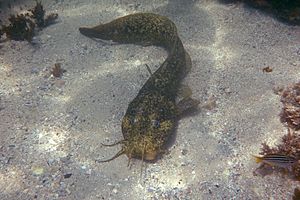Estuary cobbler facts for kids
Quick facts for kids Estuary cobbler |
|
|---|---|
 |
|
| Conservation status | |
| Scientific classification | |
| Genus: |
Cnidoglanis
|
| Species: |
macrocephalus
|
| Synonyms | |
|
|
The Estuary Cobbler, also known as the cobbler or estuary catfish, is a type of fish. It belongs to the catfish family called Plotosidae. This fish is the only species in its group, called Cnidoglanis. Its scientific name is Cnidoglanis macrocephalus.
Contents
Where Do Estuary Cobblers Live?
Estuary Cobblers live along the coast of Australia. You can find them from Queensland, down to New South Wales and South Australia. They also live in Western Australia and Tasmania. They prefer shallow waters near the shore and around reefs.
What Does an Estuary Cobbler Look Like?
The Estuary Cobbler looks a bit like two different animals. Its front half looks like a catfish. But its back half looks like an eel. These fish can grow quite large. They can be up to 91 centimeters (about 3 feet) long. They can also weigh up to 2,500 grams (about 5.5 pounds). Estuary Cobblers can live for up to 13 years.
Be careful around them! Their dorsal (top) and pectoral fins (side) have sharp spines. These spines are venomous and can cause a painful sting.
What to Do If Stung
If someone gets stung by an Estuary Cobbler, it can be painful. The best first aid is to put the injured area in hot water. This can help reduce the pain. Even though scientists discuss how it works, hot water is still the recommended treatment.
How Estuary Cobblers Live and Eat
Estuary Cobblers are marine fish that live close to shore. They like shallow bays and sandy areas near river mouths. You can often find them over sand, rocks, and weeds. They live in both clear and cloudy waters.
During the day, Estuary Cobblers often hide. They stay in holes and under ledges in riverbanks. At night, they come out to find food. They eat many different things. Their diet includes molluscs like clams and snails. They also eat crustaceans such as prawns and small shrimp-like creatures. Polychaete worms, algae, and other bits of organic material are also on their menu.
Younger cobblers eat more crustaceans. They often find these among floating plants. Adult cobblers mostly eat molluscs and polychaete worms. Larger animals also hunt Estuary Cobblers. Birds like cormorants and pelicans are some of their predators.
See also
 In Spanish: Cnidoglanis macrocephalus para niños
In Spanish: Cnidoglanis macrocephalus para niños


